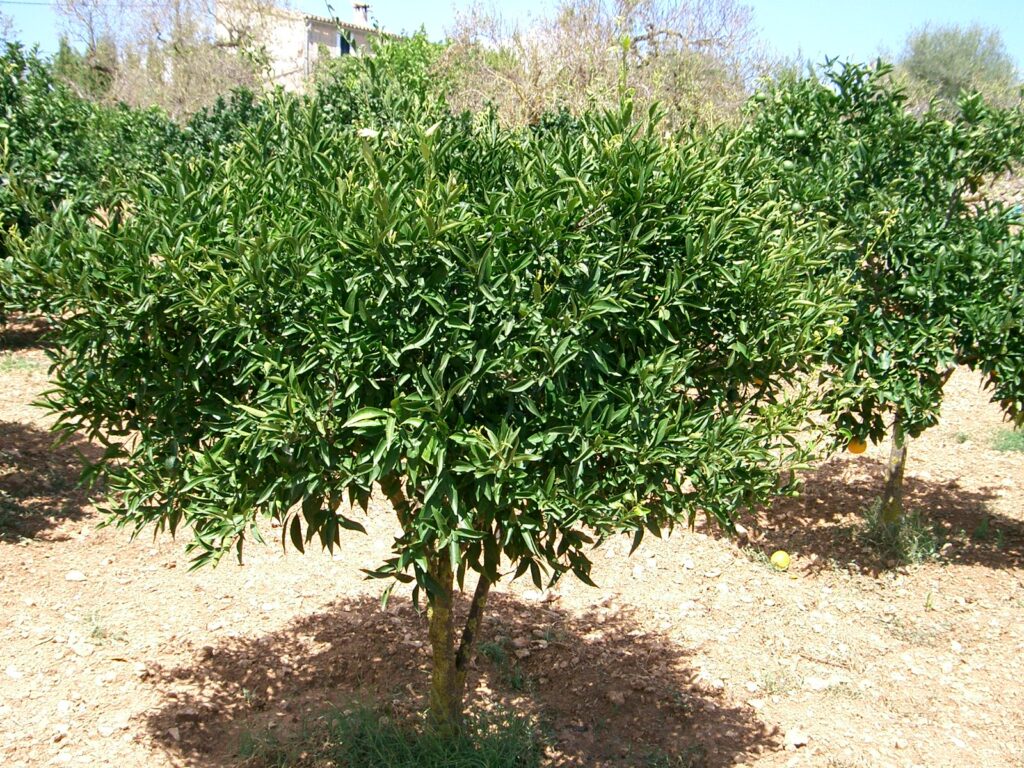Water at least weekly until established (unless you
get sufficient rain. Even water mature citrus trees regularly. Citrus trees have relatively
shallow, broad root systems. Once established, the trees may tolerate some drought, but
they won’t produce fruit that’s as good.
They don’t require heavy or regular pruning. Remove any “suckers”, or
shoots growing from the rootstock. Citrus trees are grafted, meaning that a tree with desirable
fruit is cut and attached to a sturdier rootstock. You don’t want the rootstock taking over.
Moderately thin the foliage if it grows excessively dense, to promote air circulation and
availability of light.
Generally, train citrus trees as shrubs or hedges. If you’d like to remove a few lower branches to
give it more of a tree shape, go ahead, but don’t overdo it.
: Stay away from organic mulch (wood chips,
straw, grass clippings, chopped leaves, and compost) as it increases the likelihood of foot rot
disease. A safe bet is that the roots are at least as wide as the branches, so make the mulch
area at least this large. You can even add a rim of mulch around the circumference of the circle
to aid in watering. Do not mulch right up to the base of the trunk. Leave a little margin so that the
crown has breathing room and doesn’t stay wet when you water.
Organic, seaweed-based fertilizers work very well and promote leaf/ fruit/ flower growth. You can
find various citrus fertilizers on the market, as well. It would be ideal to use a more nitrogen-rich
fertilizer in spring/summer, when trees’ leaves and stems are actively growing. During late
summer/autumn, you can use a more balanced fertilizer and then a more phosphorus/potassium
based fertilizer when the tree’s energy is directed toward its fruits rather than its leaves.
WLD (Winter Leaf Drop), CVC (citrus variegated clorosis),
Blackspot, Scab, Psorosis, Melanose, Anthracnose on dead citrus wood, Phytophthora, and
Pseudocercospora are some of the fungal and bacterial complications but most seem to be
resolvable with liquid copper, zinc sulfate, or hydrated lime.
To prevent citrus tree Root Rot, remove all decaying material such as leaves,dead weeds, and
fallen fruit from the ground surrounding the tree base, and prune lower limbs to at least two feet
above the ground.
The example of Citrus Canker causes necrotic dieback, tree decline, premature fruit drop, and
blemished fruit. There are a variety of sprays designed to protect citrus trees from Canker
infection, such as Liquid Copper Fungicide as a preventative treatment. However, already
infected trees should be removed and destroyed to prevent further contamination from the
contagious Citrus Canker disease.
Homemade fruit tree sprays are an effective way to keep the bugs and diseases away by using
common household ingredients such as vegetable oils, boric acid, soap, water, and spices, you
can create an organic pesticide to eliminate many unwanted pests. Vinegar is a fantastic way to
get rid of an ant problem. A water and vinegar solution can be sprayed anywhere that ants are
present. Neem oil (70%) is used to manage powdery mildew but is less effective on black spot
and other leaf spot diseases. Many insecticides that use combinations of different plant oils, plant
extracts, and fish oils. (common oils used in these products are garlic, canola, sesame, and
soybean).






